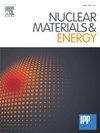Numerical assessment of ICRF-specific plasma-wall interaction in the new ITER baseline using the SSWICH-SW code
IF 2.3
2区 物理与天体物理
Q1 NUCLEAR SCIENCE & TECHNOLOGY
引用次数: 0
Abstract
In 2023, switching the material on the first wall of ITER to tungsten (W) was recommended. In magnetic Fusion devices, waves in the Ion Cyclotron Range of Frequencies (ICRF) interact with the Scrape-Off Layer (SOL) via RF-sheath rectification. This contribution re-assesses this phenomenon close to the ITER ICRF antenna, focusing on the ICRF-specific gross erosion of W from the antenna port sides. Our quantitative estimates rely on predictive multi-2D numerical simulations of the ICRF antenna environment using the SSWICH-SW code. They combine Slow Wave propagation from the antenna mouth to the SOL, the excitation of RF oscillations in the sheath voltages at the antenna port sides and a subsequent DC biasing of the SOL. Maps of the parallel RF electric field at the antenna mouth, from the antenna code TOPICA, excite the system. Our simulations cover more than four decades in the local densities near the antenna. Since both the sputtering and the local heat loads are proportional to the local particle fluxes, the most intense Plasma-Wall Interaction is found for high local density, with or without ICRF waves. In these conditions, larger margins also exist for coupling the ICRF power. We tested several operational trade-offs between these two constraints. The simulated target plasma contains 2% of neon ions. These are efficient at sputtering W, already at low accelerating voltages. Consequently, although the RF-sheath rectification sufficiently amplifies the local sputtering at the antenna port for a detection using visible spectroscopy, the ICRF-induced increment of the gross W production represents at worse 22% of the W source expected from thermal sheaths over the eighteen out-board mid-plane ports. An upper bound, independent of our main assumptions, is proposed for this enhancement factor. This moderate expected global increase questions the ability to detect ICRF-specific W contamination of the plasma core, even at the planned maximal ICRF power.
求助全文
约1分钟内获得全文
求助全文
来源期刊

Nuclear Materials and Energy
Materials Science-Materials Science (miscellaneous)
CiteScore
3.70
自引率
15.40%
发文量
175
审稿时长
20 weeks
期刊介绍:
The open-access journal Nuclear Materials and Energy is devoted to the growing field of research for material application in the production of nuclear energy. Nuclear Materials and Energy publishes original research articles of up to 6 pages in length.
 求助内容:
求助内容: 应助结果提醒方式:
应助结果提醒方式:


